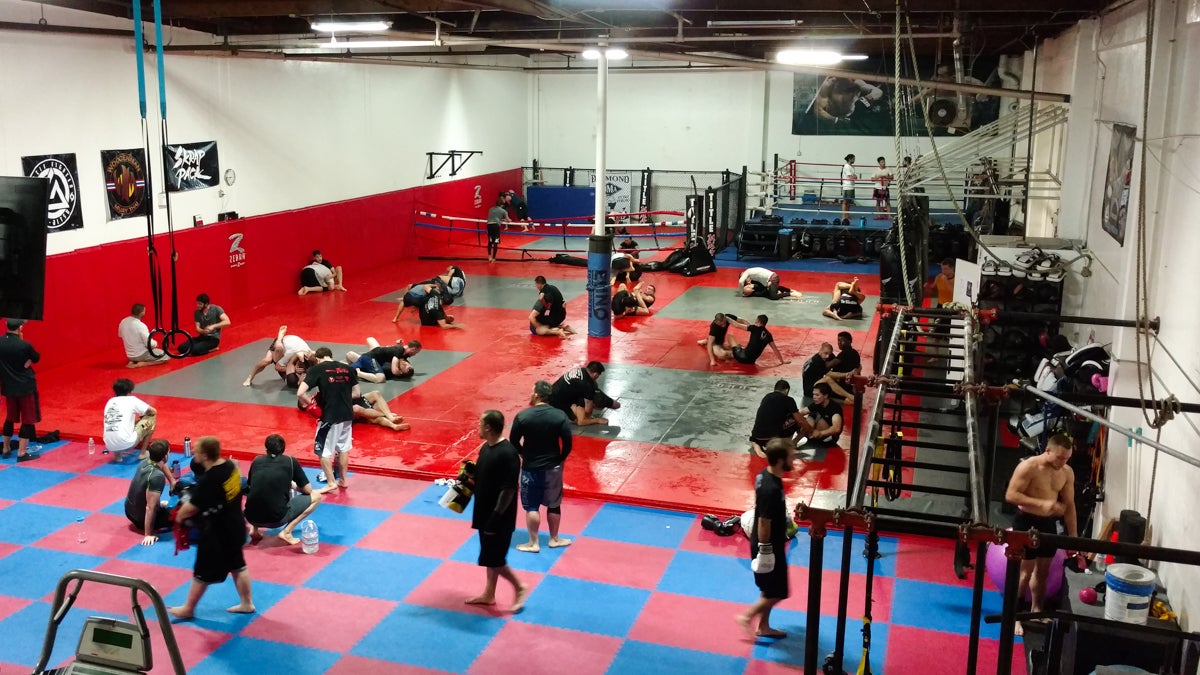Athletes chase competitive advantage by cutting weight
Listen
El Niño Training Center in San Francisco. (Andrew Stelzer/for WHYY)
In certain sports, rapid weight loss is extremely common and extremely dangerous.
Boxers, wrestlers, muay thai and mixed martial arts fighters do it, and so do weightlifters. They lose as much weight as they can and then quickly gain it all back at the last minute, supposedly to get a competitive advantage.
At El Niño Training Center in San Francisco, Josh Berkovic loses about 25 pounds before a mixed martial arts fight. He usually gets about seven weeks notice, he and says the first six weeks are easy. He trims back the carbs in his diet, exercises a lot—basic fat-burning stuff.
“You’re losing about a pound and a half to two pounds a week, so that should get you in range then for the final week to be 13 to 15 pounds over,” Berkovic says.
That last week is when the serious “cut” begins.
“You don’t want to lose muscle mass,” Berkovic says. “You don’t want to lose strength, especially for an athletic performance, so the idea is, how can I become as lean as possible going into the week of the fight?”
After that, it’s all about cutting water weight. More than 50 percent of our body weight is water, and athletes try to shed some of it by sweating. Former muay thai fighter Albert Salopek did a large weight cut once and says he never wants to do it again.
“We put this rubber sweat suit on, pants and top. You cover your skin with what’s called Albolene, which is a makeup remover, and it opens your pores. Got on the treadmill and ran like three or four miles, and with your pores open, your sweat just comes off like a river,” Salopek says.
“Probably lost four or five pounds from that, and had to go sit in a hot sauna with the sweat suit on for probably another 30, 40 minutes, ” he says.
Sweating out the water is often the first step. Then there’s the flush. Daniel Kim, who also does muay thai, starts the flush phase by drinking as much water as possible in the first few days of his “cutting weight” week.
“You drink all that water all through the day and that gets you to start peeing a lot,” Kim says. “And then 24 hours away from the weigh-in, then you stop drinking water. And then you’re still peeing. And then you don’t get to drink more water, but your body is so used to peeing at these hours, it pees out all this water and then you start getting lighter and lighter and lighter. That’s your body getting dehydrated. And then your urine gets yellower and darker.”
Dark, yellow urine is not good. People also experience muscle cramps, irregular heartbeats, and even paranoia, according to Krista-Scott Dixon, a nutrition coach at Precision Nutrition.
After athletes stop flooding their body with water, Dixon says the kidneys continue to work overtime to get it out.
“We tell the kidneys flush, flush, flush, and so they get going on that, and then we don’t replace the water, so the kidneys keep flushing, and eventually there’s no more water coming in, so we run a water deficit,” Dixon says.
Dixon used to cut weight herself. She competed in hand-to-hand combat competitions called grappling. She’d regularly shed 20 to 30 pounds before her matches.
“There’s an increased risk of brain trauma from weight cutting, and in a sport where you get hit in the head, that’s a really big problem,” Dixon says. “There’s fluid around your brain and it has a job to do, so when we deplete that, that’s gonna be an issue, too.”
About 10 years ago, in her early thirties, Dixon went too far with her weight cuts and put herself into early menopause. Estrogen is stored in fat tissue, and Dixon had so little fat on her body, she stopped producing that key hormone.
Rapid weight fluctuation can also put stress on the heart, and over time the habit can lead to an eating disorder.
Pressure to perform
Cutting weight is especially dangerous for adolescents, whose bodies need fuel not only to survive, but also to grow. Greco Roman wrestler Donte Burney, who started cutting weight when he was 13, says he’s cut as much as 20 pounds in three days.
As a high school wrestler in Indiana, Burney weighed about 150 pounds. He says a coach asked him to cut 25 pounds to fight a 125-pound opponent. He slimmed down, but then the goalpost moved. His opponent had dropped down to the 119-pound weight class–so Burney had to make that cut too.
“Talking to my coach, and I was like ‘Man, I don’t know if I can do it.’ And he said, ‘Maybe you’re scared?’ That kind of lit some fire under me, and all night long I was running until I made the 119 weight class,” Burney says.
At the start of the match the next day, Burney was winning.
“And then second period began. [My opponent] blasted me with a double leg, and after that I remember just being in a hospital,” he says.
Burney blacked out. His kidneys nearly failed, and he could have died.
Doctors barred him from fighting under 140 pounds for the rest of the year, but Burney wasn’t scared away. As an adult he took ephedrine, a fat-burning stimulant, to lose weight for another match. He landed in the hospital again, this time with a dangerous heart condition. It was only then that he started to realize what he could do to his body.
Among professionals, the pressure to is financial: for professional boxers there’s big money at stake if they show up for a fight 1 or 2 pounds heavier than their contract requires. In high school and college, it’s about scholarships, pride, and accolades.
Lose to win
But, at any level, the point of cutting weight is to gain a competitive advantage.
Former North American Boxing Organization junior welterweight champion Karim “Hard Hitta” Mayfield cuts about 20 pounds off his “walking around weight” so he can box in a lower weight class. But then after qualifying at the weigh-in, Mayfield spends the next 24 hours trying to gain all of that weight back, by eating and drinking as much as he can. When he steps in the ring, he actually wants to be 20 pounds heavier than his opponent.
“You may watch a fight and think, wait a minute, it said he was 150 yesterday at the weigh-ins, and now he’s 165–like how?” Mayfield says.
This is totally legal, in most cases. But the premise is faulty since usually, both fighters are cutting weight — and then gaining it back before the fight. No one really gets an advantage, and everybody knows it. Still, they do it anyway.
In the past few years, at least three MMA fighters have died during weight cuts. In one case, the fighter was taking a diuretic, a medicine that makes the body expel water and salt though frequent urination. Other fighters take laxatives, hoping to lose a few pounds of poop before they step on the scales.
Dave Zirin, host of the podcast “The Edge of Sports,” says the media spotlight has begun to rein in the dangers of win-at-all-costs machismo sports culture.
“It takes tragedy to provoke consciousness, unfortunately,” Zirin says.
He says that’s what happened to get more people to pay attention to head injuries in football.
“It will take high profile incidents, almost certainly of death, to be able to raise the awareness to a point where it’s regulated in a way to the benefit of young athletes,” Zirin says.
Sports organizations are slowly reining in the tradition of cutting weight. The NCAA, the governing body for college sports, has instituted rules to discourage rapid weight loss and gain in the days before a match.
The UFC, the largest Mixed Martial Arts promoter in the world, recently created a rule that fighters must be within 8 percent of their target weight four days before the fight.
And some athletes are policing themselves in the interest of their own health.
Strength coach Tom Campitelli, who runs small power-lifting competitions out of a gym in Oakland, recently started experimenting with something called a “weigh-out.” Lifters step on the scale immediately after competing. Then their performance is match with athletes who weighed in within the same range.
“I think it makes for a better competition in a lot of ways,” Campitelli says. “It ensures that people actually compete in a more level playing field of sorts.”
The “weigh-out” could help address the problem in sports like weightlifting, where your results can be compared to others competitors’ after the fact. But it likely wouldn’t help much in one-on-one sports such as boxing, where you can’t switch your opponent after you’ve already finished fighting.
WHYY is your source for fact-based, in-depth journalism and information. As a nonprofit organization, we rely on financial support from readers like you. Please give today.






